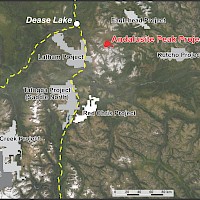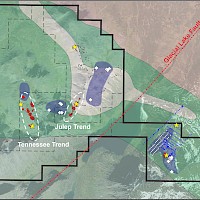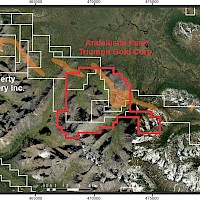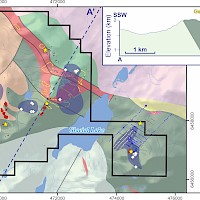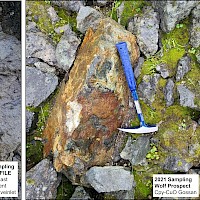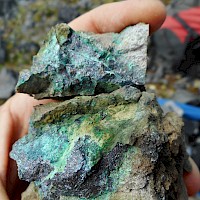Exploration of the Andalusite Peak property in 2018 included prospecting and alteration mapping that resulted in discovery of two mineralized trends in the footwall of a thick alteration blowout characterized by an intermediate to advanced argillic alteration assemblage. The mineral claim cover a zone of alteration that is the center of a 27-kilometer stretch of intermediate to advanced argillic alteration containing assemblages of quartz-sericite- clay-pyrite (van Straaten and Gibson 2017). This stretch of alteration is delimited on either side of the Andalusite Peak property by occurrences of porphyry-style mineralization and quartzsericite- pyrite alteration with local K-feldspar-magnetite alteration assemblages, found on the Tanzilla property, 11 km to the northwest (Kaizen Discovery), and the McBride property, 12 km to the southeast (Teck Resources).
Andalusite Peak
Summary
Location
The Andalusite Peak property is located approximately 36 km southeast of Dease Lake, BC, and 410 km north-northwest of Smithers, BC, within the Stikine Plateau of the Liard Mining Division (Figure 1). At a larger scale, the property specifically lies northeast of Horn Mountain, abutting Glacial Lake to the east, at a latitude of 58o 16’ 33” N and longitude of 129o 28’ 40” W (UTM NAD83, Zone 9N) and on NTS 104 I/5, 6; BCGS 104I 023.
Geology
The Andalusite Peak property is located along the northeastern margin of the Stikine terrane. Stikinia is an allochthonous Triassic-Jurassic island arc complex built upon para-autochthonous Devonian to Permian carbonate and metavolcanic units (Stikine Assemblage) outboard from the western Laurentian margin prior to accreting to ancestral North America (Mihalynuk et al. 1994; Nelson and Colpron 2007). The volcanic and related sedimentary rocks of the Late Triassic Stuhini Group and Lower Jurassic Hazelton Group are the dominant exposed Stikinia units in the northern part of the terrane (Currie and Parrish 1997). The Lower Cretaceous Bowser Lake Group and Upper Cretaceous Sustut Groups are postaccretionary clastic sedimentary units that overlie the Stikinia volcanic rocks (Evenchick and Thorkelson 2005).
The tenure is in the northern part of Stikinia, termed the ‘Stikine Arch’ in British Columbia, where plutonic suites are associated with large Cu-Au-Ag+/-Mo porphyry-style mineral deposits (e.g., KSM, Galore Creek, Schaft Creek, Red Chris, Kemess; Figure 3). Intrusive suites that occur within Stikinia include the Forest-Kerr (Devono-Carboniferous), the Stikine and Copper Mountain (Late Triassic), the Texas Creek and Cone Mountain (Early Jurassic), and Three Sisters (Middle Jurassic; Anderson 1983, 1993; Brown et al. 1996; Logan et al. 2000). Plutonic rocks in the mineral tenure area include those of the mid- to Late Triassic Stikine suite (Cake Hill pluton, south-southwest of the tenure), the Middle Jurassic Three Sisters suite, and the early Late Jurassic Snowdrift Creek pluton (van Straaten and Gibson 2017).

